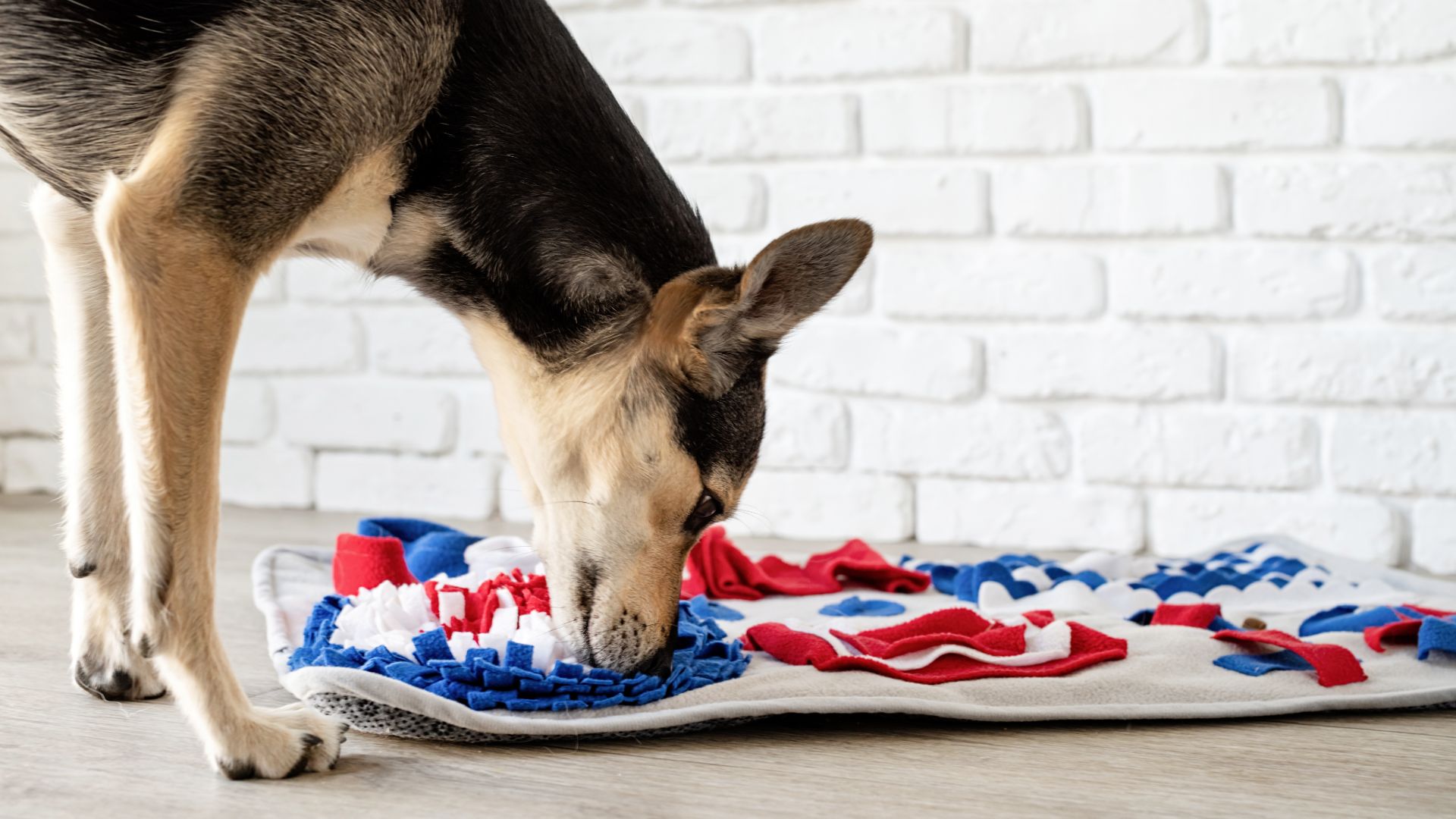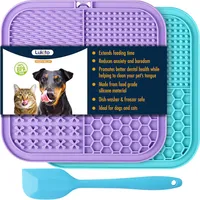Are snuffle mats good for dogs?
Our vet Dr. Joanna Woodnutt shares her expert knowledge on whether snuffle mats are good for dogs, including all the pros and cons

Are snuffle mats good for dogs? Most pet owners are devoted to enhancing the quality of life for their furry friends. One way to achieve this is by providing them with mental and physical stimulation through interactive toys. Enter the snuffle mat – a popular choice among dog owners. But what exactly is a snuffle mat, and are they truly beneficial for our canine companions?
The best snuffle mats for dogs are specially designed to engage their incredible sense of smell, offering them an opportunity to forage and search for the best dry dog food in an exciting and rewarding way. By tapping into a dog's natural instincts and providing an engaging activity, snuffle mats can offer numerous benefits. These mats stimulate the dog's sense of smell, which is incredibly powerful and vital to their well-being. Engaging their olfactory senses can provide mental stimulation, alleviate boredom, and even offer a sense of accomplishment as they work to find their hidden treats.
We turn to Dr. Joanna Woodnutt, a trained vet with a wealth of knowledge and experience, to explore the benefits and potential drawbacks of incorporating a snuffle mat into your dog's routine. Whether you're considering purchasing a snuffle mat for the first time or simply curious about its effectiveness, Dr. Woodnutt will provide invaluable insights to help you make an informed decision for your beloved furry friend.
What is a snuffle mat?
Snuffle mats are a type of dog puzzle toy. They are designed to hide dry food, making it more difficult to eat and encouraging dogs to use their hunting skills to locate it. A snuffle mat consists of a rubber, fabric, or plastic mat base. Fabric (usually fleece) is then knotted or sewn into the base with long tails left sticking up as if to imitate grass. Dry food, treats, or kibble can then be sprinkled into the mat so that the dog has to seek it out.
Most dogs love using a snuffle mat as it allows them to use their powerful sense of smell to hunt out food. They come in various shapes and sizes. Some are washable, some have a heavy base to help them stay in one place, and there are even instructions for DIY snuffle mats.
Benefits of snuffle mats
So why should you use a snuffle mat for your dog or puppy? Well, there are lots of benefits of snuffle mats – let’s take a look at some of the main ones.
1. Provide mental stimulation to reduce boredom
Do dogs get bored? Yes, they do and bored dogs are prone to naughty behaviors. Food is one of the best ways to motivate dogs and give them something to do all day.
Get the best advice, tips and top tech for your beloved Pets
Dogs in the wild would have spent many hours looking for food, whereas pet dogs are served up their dinner in a bowl of food that is finished within minutes. This leaves plenty of time in his day for your dog to have to try and fill in other ways. Some dogs can become destructive or show other negative behaviors if they don’t receive enough mental stimulation.
Using a snuffle mat means your dog can forage for his food, giving him mental stimulation. This is especially important in those that can’t have their usual mental or physical stimulation – for instance, those on restricted exercise as part of a recovery program from an injury or surgery.
2. Slows down eating to avoid bloat and stomach pain
It's worthwhile noting that the question ‘Why does my dog eat fast‘ is a common question asked by dog owners. There are various potential reasons for this including but not limited to competitiveness, underfeeding and food quality.
If you are the owner of a dog who gobbles his food too quickly then you're probably familiar with some of the effects of his speedy eating. Some dogs even use their abdominal muscles to create a vacuum, literally hoovering down their food. Vomiting, regurgitation, diarrhea, stomach pain, and even bloat are all common in dogs that eat too quickly. Luckily, using a snuffle mat is one of the ways that you can slow down their eating to reduce the risk of these things occurring.
3. Burns energy for a calmer dog
If your dog is full of energy and always on the go, then you’ll be pleased to hear that the snuffle mat can help them to calm down. As well as providing mental stimulation, the sniffing and foraging behaviors help to produce happy hormones and allows your dog to focus for a while. Spending 15 minutes using their brain in this way can be just as tiring as walking for an hour, so it’s a great way to get them to burn energy while you get on with other things!
4. Provides entertainment to help curb separation anxiety
Snuffle mats, along with other food puzzle toys, can help with separation anxiety in dogs. These toys can give your dog a welcome distraction when you leave the house, giving them something else to think about. They can also help your dog to play independently without you needing to be by his side all the time. If your dog is already suffering from separation anxiety, then you should talk to a dog behaviorist about appropriate steps to take alongside the snuffle mat. Other training methods are likely to be needed alongside these toys to help your pet.
5. Encourages use of the brain to help stave off doggy dementia
Doggy dementia (or ‘Canine Cognitive Dysfunction’/CCD) is a common condition of older dogs. Like humans, dogs suffering with dementia become anxious in their senior years. They struggle to remember commands and may forget their toilet training. Some dogs can become forgetful day-to-day, too, and their sleep-wake cycle can change, causing insomnia. It’s thought that the onset of canine dementia can be slowed by encouraging dogs to continue using their brains as they age. In other words, a snuffle mat works like a Sudoku to help senior brains stay active!
6. Helps with doggy diets by reducing begging
Sadly, many modern dogs are overweight. In fact, it’s so common that vets consider it to be one of the most concerning welfare issues dogs are facing, as mentioned in a recent Journal of Applied Animal Welfare Science paper. Unfortunately, ‘giving in when my pet begs for food’ is one of the most common reasons given by owners for dogs to be overweight. One advantage of snuffle mats is that they slow down eating, giving the body time to recognize the fact it’s full. Dogs fed slowly will feel full towards the end of their meal, reducing the amount of begging occurring afterwards. In turn, this should help owners stick to their dog’s diet and help them shift those extra pounds!
7. It gives their nose a good workout
One of the senses that dogs rely on most is their sense of smell. Dogs are constantly using their noses when out on walks, taking pleasure in sniffing out all sorts of interesting things. At home, a dog’s life can be a bit more boring. The snuffle mat gives them an extra opportunity to give their nose a good workout. Most dogs enjoy the action of sniffing things out just as much as they do the food reward at the end!
Sometimes these mats are used to help train working animals like search and rescue or sniffer dogs. They are sometimes referred to as nosework mats when used in this way.
Do snuffle mats have any downsides?
Well, put simply, not really. In fact, I asked a large group of vets what they thought, and nobody has seen any medical or behavioral issues with them!
Of course, theoretically, they could prove a choking hazard or end up as a foreign object if your dog chews and swallows the mat – so supervise your dog and make sure they’re using it correctly, especially if they’re a known ‘chewer’. As with all of the best dog toys, you should remove and replace them when it becomes old or torn to reduce the chances of pieces coming off and being swallowed.
Make sure you keep the snuffle mat clean. Small bits of food that have been missed by your dog could go stale or encourage pests, so check it regularly. Some mats can be machine washed whereas others might need handwashing. Either way, it’s a good idea to give your mat a good clean now and then to keep things fresh.
Snuffle mats can only be used with dried treats or kibble. Anything else will make a big mess of your fabric mat pretty quickly! If your dog only eats wet food, then you should try an alternative like a rubber Kong-type toy or a lick mat.
This lick mat has suction cups on the back , which makes it a good distraction toy for bathing, grooming or nail trimming. It also has four different textured surfaces that are ideal for spreadable treats.
It can be used to extend feeding time, aid digestion and calm pets.
In some dogs that show resource-guarding behaviors, snuffle mats may not be a good choice. Increasing the length of time it takes a dog to eat his food is fine for many dogs, but if a dog is anxious and guarding his food it might be best to let him eat as quickly as he likes, especially if there are other pets in the house that might come sniffing! If your dog guards his food from other pets or people, you should talk to a behaviorist about the best ways to help, as resource guarding can be very dangerous.
It’s also worth bearing in mind that brachycephalic breeds (like pugs or English Bulldogs) may struggle with snuffle mats. Their flat faces mean they can’t poke their noses deep into the snuffle mat to get treats out.

So, that’s it! To answer ‘are snuffle mats good for dogs’, we can say they are a great way to entertain a pooch and provide them with mental stimulation as well as slow their eating. Working for your food is far more entertaining and rewarding than simply being given a large bowl full, and the best snuffle mats are suitable for puppies, elderly dogs, and those recovering from physical injury or surgery. Why not give it a go?
If you fancy learning more then stick with us and find out how to calm a reactive dog or how to stop a puppy barking.

Rebecca is a vet surgeon who graduated from the Royal Veterinary College in 2009. She has a wealth of experience in first opinion small animal practice, having done a mixture of day-to-day routine work, on-call emergency duties and managerial roles over the years. She enjoys medicine in particular and she is proud to have recently achieved a BSAVA postgraduate certificate in small animal medicine (with commendation). She writes on various feline and canine topics, including behavior, nutrition, and health. Outside of work and writing she enjoys walking her own dog, spending time with her young family and baking!
After graduating as a vet from the University of Nottingham in 2016, Dr. Joanna Woodnutt went on to practice companion animal medicine in the Midlands. She quickly developed a love of consulting and helping clients with medical problems such as dermatology, behavior and nutrition - anything that involved helping clients understand their pets better.
Jo started writing about pet health in 2017, realizing that it meant she could help even more pet parents. Since then, she has written for countless online and print publications and is a regular contributor for Edition Dog Magazine. Jo is the director of The Veterinary Content Company, which she founded in 2020. She is also the founder of Petlearnia, a platform that provides pet e-learning courses for pet parents.
Jo now lives in the Channel Islands with her husband Ian and terrier Pixie.


